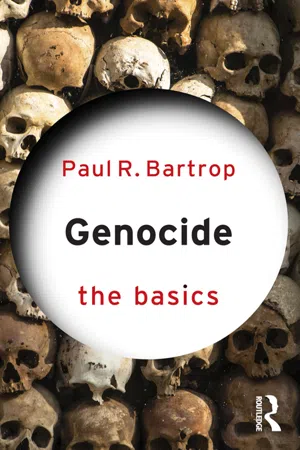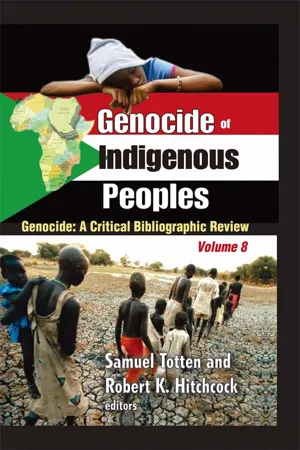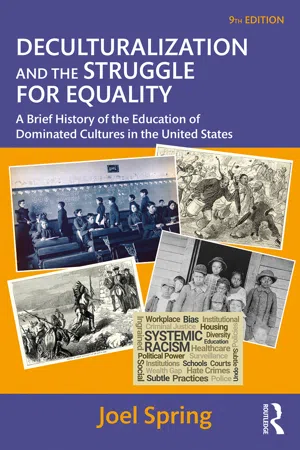History
Destruction of Native American Societies
The destruction of Native American societies refers to the devastating impact of European colonization on the indigenous peoples of the Americas. This included forced displacement, disease, warfare, and cultural suppression, leading to the decimation of native populations and the erosion of traditional ways of life. The consequences of this destruction continue to be felt in contemporary society.
Written by Perlego with AI-assistance
Related key terms
Related key terms
1 of 4
Related key terms
1 of 3
6 Key excerpts on "Destruction of Native American Societies"
- eBook - ePub
- Suzanne Crawford O Brien(Author)
- 2015(Publication Date)
- Routledge(Publisher)
Cherokee removal demonstrated the inherent inconsistency of assimilationist policies, for even the seemingly almost perfectly assimilated Cherokee were no match for Euroamerican demands for land and mineral development. This instance, and many others that followed, illustrate that even those federal policies originally formulated with good intentions were complicated by deeply held convictions that Native people must ultimately be removed from the land, opening the country to Euroamerican control. The goal of nearly every federal policy, whether for removal or assimilation, has tended toward the cultural, and at times physical, elimination of Native people.This is further illustrated by the decades of expansion that followed. During this time, large numbers of Euroamericans traveled west in search of land, as did Native nations that had been displaced from their homes in the east. This westward expansion prompted widespread violence across the western frontier as Native nations resisted encroachment on their territory. By 1850, the United States army had forced most Native communities onto reservations, many of which had negotiated treaties with the federal government to protect certain rights and access to traditional subsistence resources.These reservations disrupted indigenous religious life in countless ways. Indigenous traditions had their roots in sacred spaces within their traditional landbase. Locked into reservations, Native people lost access to many of their most important sacred sites, including essential locations in which they traditionally conducted ceremonies and to which they went for vision quests. In return for moving onto reservations, Native people were promised food, clothing, housing, medical care, and education—in the language of the treaties, “all goods and services necessary for civilization.” But such supplies often did not arrive. Government agents often misappropriated funds and rations, redirecting them for their own profit. In the mid- to late nineteenth century, Native people confined to reservations faced starvation, escalating rates of disease, inadequate medical care, and a lack of proper clothing or housing.Seeing the poverty, violence, and neglect produced by the reservation system, federal reformers began to call for an end to the segregation of reservation life. They insisted that (despite what was promised in treaties) reservations had been intentionally designed as temporary locations for Native people while they underwent the assimilation process. The reformers argued that assimilation was the only hope for Native people, and that it would, conveniently, open up reservation land to Euroamerican settlement. President Grant’s 1869 Peace Policy was developed to safeguard this Euroamerican expansion west by promoting the assimilation of tribes living in lands desired by settlers. Grant established as a Board of Indian Commissioners a group of Christian laymen, and he assigned them to monitor officials from the Bureau of Indian Affairs (BIA) and recommend appointments to agency posts.4 Missionaries, Grant reasoned, would be less likely to seek monetary benefit or to rob the people they were appointed to serve, and would simultaneously be responsible for political leadership, distribution of rations, medical care, and the task of civilizing the Indians. Grant’s administration established a system of boarding schools, convinced that they were the most expedient and effective way of educating students into English, Christianity, and the virtues of Western education. On numerous reservations, children were forcibly removed from their homes and communities; often they were not allowed to return for years. The traditional family structure of tribes was torn apart. The Peace Policy, although initiated as an effort to reform a troubled system, ultimately failed.5 - eBook - ePub
- Paul R. Bartrop(Author)
- 2014(Publication Date)
- Routledge(Publisher)
Individual murders, occasional massacres, and wholesale annihilation in long-term campaigns facilitated violent destruction. That genocide of specific Native American groups took place is beyond doubt; but this must be tempered by the qualification that not all destruction or population collapse occurred as the result of deliberate intent on the part of the settlers. On those occasions where intent can be detected, a case for genocide might be prosecuted, but the disintegration of the Native American world was not a monolithic event and must, therefore, be examined carefully and thoroughly, with an eye to the particularity of each people, region, and time period, and without preconceived opinions. The forced removal of the Native American peoples of the south-east of the United States presents us with one such dilemma. Can this be considered a case of genocide? In 1830, US President Andrew Jackson (1767–1845) signed the Indian Removal Act, a law ordering the compulsory relocation of Native American peoples living east of the Mississippi River to a designated territory to the west. These peoples were known as the “Five Civilised Tribes,” comprising the Cherokee, Choctaw, Creek, Chickasaw, and Seminole nations. They had adapted to European ways and taken the elements most suited to improving their quality of life, while at the same time retaining their sovereign integrity and folkways. After the Indian Removal Act, however, they were forced to cede their lands to the United States and move to other territories many hundreds of miles away. The first transfer was of the Choctaw Nation: between 1831 and 1834, most members were forced westward at the point of Federal bayonets, and in appalling conditions. Because Federal expenses for removal were inadequate, there were shortages of food, unsatisfactory means of transportation, and little in the way of warm clothing or blankets - eBook - ePub
Genocide of Indigenous Peoples
A Critical Bibliographic Review
- Robert Hitchcock(Author)
- 2017(Publication Date)
- Routledge(Publisher)
intent to destroy a targeted group in whole or in part. This consideration greatly complicates the issue.The demographic collapse which Euro-American contact precipitated and perpetuated in Native America spans centuries and involves no less than eight colonial or federal governments, and thousands of distinct indigenous empires, cultures, and confederacies. How does one parse out the overall demographic decline of Native America as a whole into the appropriately specific geographic and chronologic terms? Furthermore, in ascertaining the commission of genocide, taking into consideration the issue of intent, how can such monumental numbers be properly assigned to the intent of innumerable separate and distinct Euro-American – Native American relationships? To label North America’s indigenous populations in such monolithic terms is more than problematic. To generalize about the actions and reactions of all officials at the federal, regional and local levels vis-à-vis their treatment of all Native American groups is equally problematic. To attempt to extrapolate from one case where there was clear genocidal intent to all other cases – across centuries and historical contexts – is to rely on inherently faulty methodological processes.One way to avoid unfairly extrapolating hemispheric or continental conclusions from regional histories is to refocus the scope of such research. While it is possible that a large composite of isolated events may speak to the existence of broader general trends, those more narrowly focused regional histories must be better understood before such conclusions can be fully supported. The concept of genocide in Native American history must first be analyzed in the micro, rather than macro scale. Once the sundry remote histories of possible genocide in Native North America are better documented and interpreted, and boast a more exhaustive historiography, broader generalized study of genocide in North America as a whole will be more productive, balanced, and substantive. - eBook - ePub
Silencing the Opposition
How the U.S. Government Suppressed Freedom of Expression During Major Crises, Second Edition
- Craig R. Smith, Craig R. Smith(Authors)
- 2011(Publication Date)
- SUNY Press(Publisher)
The experiences of the Delaware, Cherokee, and Willamette Valley peoples are but a small sample of events typical of the policy of removal. The coerced ceding of territory by Native Americans uprooted them from their ancestral homelands, altered their lifestyle and subjected them to a control that promoted dependence and impotence. By isolating them from white settlers while treating them as pseudo-sovereign, the policy denied them access to decision-making systems that determined their fates. Thus silenced in the name of protection, they found themselves with no legitimate voice until at least 1924, the year of Native American suffrage. More significantly, however, their being uprooted from their lands severely restricted their religious freedom because of the centrality of land to their notion of spirituality. Hence, a policy with at least some benevolent motivation effectively stifled many peoples and significantly altered the basis for their spiritual existence.Annihilation
In 1607 Jamestown became home for settlers sent by an English trading company expecting to make profit in the colonies. Although saved from starvation by the Powhatan, the colonists seized lands the Indians had cleared, killing many in the process. The tribe watched as the colony grew. In desperation, they attacked a White settlement in 1622, killing 346 Europeans. Edward Waterhouse of the Virginia Company describes settler's response to the attack:We many now by right of Warre, and law of Nations, … destroy them who sought to destroy us…. [C]onquering them is much more easie then of civilizing them, … for they are a … barbarous … people…. [V]ictorie … may be gained … by force, by surprise, by famine in burning their corn, by destroying and burning their Boats, Canoes, and Houses, by breaking their fishing Weares…. [These] naked, tanned, deformed Savages … are so fierce, … may their ruine or subjection be soone effected.27 - eBook - ePub
- Britannica Educational Publishing, J.E. Luebering(Authors)
- 2010(Publication Date)
- Britannica Educational Publishing(Publisher)
Although life has changed drastically for many tribal members, a number of indicators, such as the proportion of students who complete secondary school, the level of unemployment, and the median household income, show that native people in the United States and Canada have had more difficulty in achieving economic success than non-Indians. Historical inequities have clearly contributed to this situation. In the United States, for instance, banks cannot repossess buildings on government trust lands, so most Indians have been unable to obtain mortgages unless they leave the reservation. This regulation in turn leads to depopulation and substandard housing on the reserve, problems that are not easily resolved without fundamental changes in regulatory policy.The effects of poorly considered government policies are also evident in less-obvious ways. For example, many former residential-school students did not parent well, and an unusually high number of them suffered from posttraumatic stress disorder. Fortunately, social service agencies found that mental health care, parenting classes, and other actions could resolve many of the problems that flowed from the boarding school experience.While most researchers and Indians agree that historical inequities are the source of many problems, they also tend to agree that the resolution of such issues ultimately lies within native communities themselves. Thus, most nations continue to pursue sovereignty, the right to self-determination, as an important focus of activism, especially in terms of its role in tribal well-being, cultural traditions, and economic development. Questions of who or what has the ultimate authority over native nations and individuals, and under what circumstances, remain among the most important, albeit contentious and misunderstood, aspects of contemporary Native American life.Although community self-governance was the core right that indigenous Americans sought to maintain from the advent of colonialism onward, the strategies they used to achieve it evolved over time. The period from the Columbian landfall to the late 19th century might be characterized as a time when Native Americans fought to preserve sovereignty by using economics, diplomacy, and force to resist military conquest. From the late 19th century to the middle of the 20th, political sovereignty, and especially the enforcement of treaty agreements, was a primary focus of indigenous activism; local, regional, and pan-Indian resistance to the allotment of communally owned land, to the mandatory attendance of children at boarding schools, and to the termination of tribal rights and perquisites all grew from the basic tenets of the sovereignty movement. By the mid-1960s the civil rights movement had educated many peoples about the philosophy of equal treatment under the law—essentially the application of the sovereign entity’s authority over the individual—and civil rights joined sovereignty as a focus of Indian activism. - eBook - ePub
Deculturalization and the Struggle for Equality
A Brief History of the Education of Dominated Cultures in the United States
- Joel Spring(Author)
- 2021(Publication Date)
- Routledge(Publisher)
Chapter 1 , these destructive actions are based on a belief that some cultures and languages are superior to others. In many cases, this has resulted in inequality of educational opportunity.As a result of globalization and imperialism, indigenous peoples have been forced to undergo extreme cultural change, resulting in many becoming socially and psychologically dysfunctional. Native Americans are part of the world’s indigenous peoples. The International Labor Office defines indigenous peoples as “populations which inhabited the country, or a geographical region to which the country belongs, at the time of conquest or colonization.”2 The United Nations provides the following description:Indigenous peoples are descendants of the original inhabitants of many lands, strikingly varied in their cultures, religions and patterns of social and economic organization. At least 5,000 indigenous groups can be distinguished by linguistic and cultural differences and by geographical separation. Some are hunters and gatherers, while others live in cities and participate fully in the culture of their national society. But all indigenous peoples retain a strong sense of their distinct cultures, the most salient feature of which is a special relationship to the land.3Most indigenous peoples suffered at the hands of their conquerors, particularly in the Americas. Besides Native Americans in the United States and the First Nations in Canada, many indigenous peoples throughout Central and South America experienced some form of deculturalization. To rectify the attempts at deculturalization of indigenous peoples, Article 27 of the Indigenous and Tribal Peoples Convention, 1989, promises that education for indigenous peoples “shall be developed and implemented in cooperation with them to address their special needs, and shall incorporate their histories, their knowledge and technologies, their value systems and their further social, economic and cultural aspirations.”4
Index pages curate the most relevant extracts from our library of academic textbooks. They’ve been created using an in-house natural language model (NLM), each adding context and meaning to key research topics.
Explore more topic indexes
Explore more topic indexes
1 of 6
Explore more topic indexes
1 of 4





